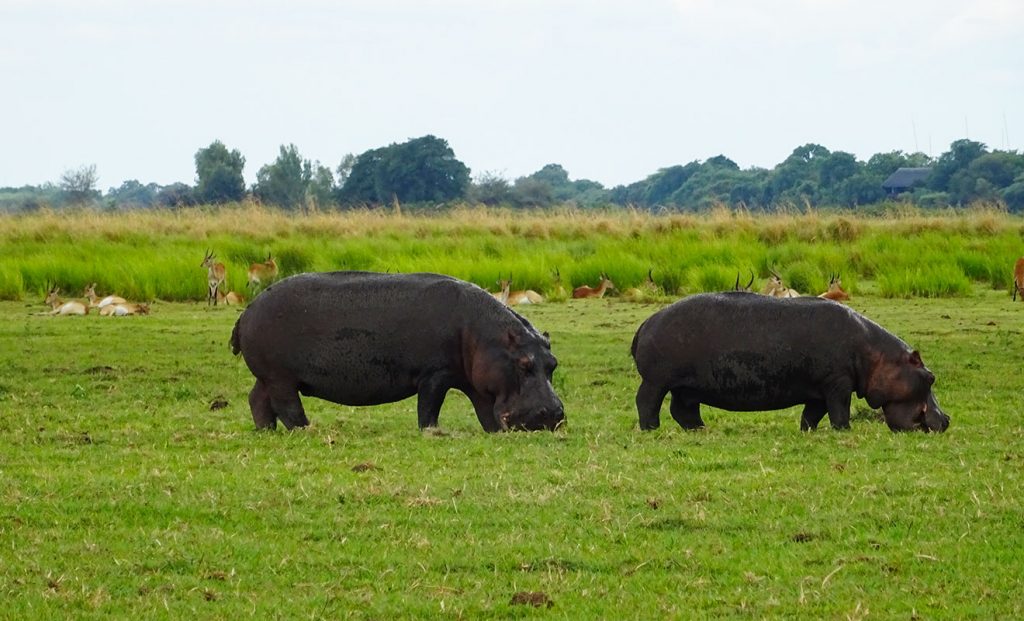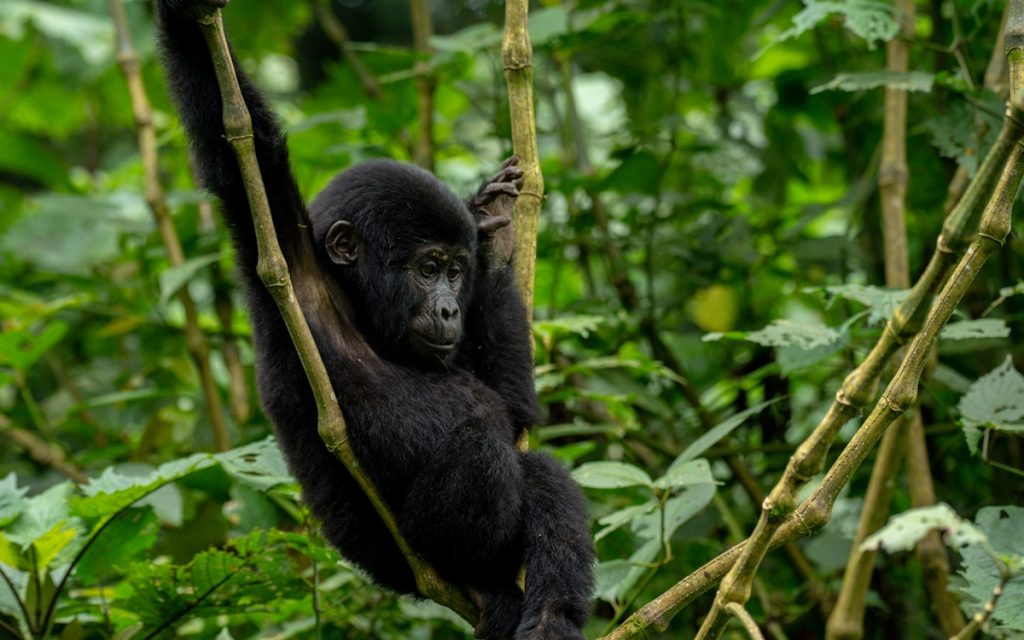- Written by: Anthony
- September 4, 2025
What do Hippos eat? Hippopotamus diet, sex, weight & Facts
What do Hippos eat? Hippopotamus diet, sex, weight & Facts
Despite the giant hippo size and look, Hippopotamus also referred to as hippos are purely herbivores feeding strictly on vegetation.
Looking at how giant the hippo is, it’s hard to believe that this massive size and strength is derived purely from eating grass. Hippo’s eating habits is surprisingly simple and effective.
They feed primarily on grass, particularly the short grasses found closest to rivers and lake shores. These grasses are easy to graze on and provide sufficient nutrients needed to sustain their large bodies and power.
Rarely, you will find, hippos eating fruits or some aquatic plants if they are readily available, but this is definitely a one in a million chance.
Even if the hippo may be tempted to feed on the appetizing meat, they are unable to. Hippo’s digestive systems are designed specifically for plant-based food, so their diet rarely deviates from this pattern.

Two hippos grazing in Queen Elizabeth National park
Diet Overview
Primary food: Short grasses make up about 80-90% of their diet.
Occasional consumption: Small amounts of fruits or aquatic plants if available.
What they avoid: Hippos do not eat meat or fish under normal circumstances.
Feeding Routine
Night grazing: Hippos leave the water at dusk to graze on land. They can travel up to 10 km each night searching for food.
In average, a hippo may eat about 35 kg of grass per night, which is less than you’d expect for their size.
Much as hippos spend most of their day in water, they feed at night on land and graze for about 5-6 hours every day.
When feeding, hippos usualy remain close to their home watercourse, keeping about 1-3km during the nighttime feeding.
To eat, a hippo will use its horny lips to grasp the grass and tear it as it moves it’s head from side to side. The hippo horny lip may measure up to 20inch wide for a male hippo. Weakly rooted grasses are eliminated from the grazing areas with this action
Some of the most common hippo vegetation diet’s may include; Cynodon, Panicum, Heteropogon, Sporobolus, Themeda, Cynodon, Digitaria, Eriochloa, Tragus, Brachiaria, Urochloa, Chloris, Setaria, Cyperus.
Compared to many artiodactyls, hippos aren’t ruminant. They eat by grounding coarsely by back molars; front teeth not used in feeding
However, hippos have a multi- chambered stomach where carbohydrates are fermented; two days’ worth of grasses can be held at one time.
One main reason why hippos have a huge bod size is because of Slow rate of digestion derives maximum benefit from a nutrient poor diet of grasses and dry forage.
Also because of their low metabolic rate allows survival for many weeks without food
Suggested Safari Itineraries
Adaptations for Feeding
Mouth structure: Their wide mouths and strong lips allow them to pull and chew tough grass efficiently.
Energy use: Despite their size, hippos have a slow metabolism, so they don’t need to eat as much as other large herbivores.
The Hippo’s alimentary canal is long enough to give hippos a very slow digestion. For this reason, hippos can hibernate and survive without food for a long time.
Hippos follow the same trail when feeding however, they may deviate for about 2kilometers per day from the same grazing ground of the previous day.
 Do Hippos Ever Eat Meat?
Do Hippos Ever Eat Meat?
During an African Safari, you may see hippos tearing animals including lions or you might have watched this in television films.
After watching this, you may be tempted to think hippos eat meat – but, precisely put; hippos do not eat meat. Their diet is primarily vegetation.
There are rare cases where hippos have been observed feeding on fellow animals’ flesh. This is not common and usually happens during food shortages or unusual circumstances.
Even then, meat consumption is not natural for hippos and does not align with their digestive systems design. Their stomachs are built to process plant material, and their teeth are suited for grinding grass, not tearing flesh.
Next time you see hippos eating flesh – Such behavior is an anomaly not a characterized behaviors of hippos.
Hippo’s role in the ecosystem lifecycle
The role of diet in a hippo’s life goes beyond simple sustenance. Their feeding habits influence not just their health but also the ecosystems they inhabit.
By grazing on grasslands, hippos help maintain open spaces, which can benefit other animals by creating habitats and pathways.
Furthermore, their selective grazing can shape the types of vegetation that grow in an area, indirectly impacting biodiversity.
In times of scarcity, their ability to adapt—such as eating aquatic plants—shows their resilience in environments where resources might fluctuate.
Also, the hippos directly defecate into the waters causing a massive buildup of microorganisms useful for fish, insect, human and other aquatic habitats.
Recommended Safaris
Other Hippo Facts
Hippos are regarded as nocturnal amphibian mammals, they spend most of their time sleeping during day and are more active at night.
In case of a drought or shortage of food, hippos may migrate up to 60km in search of better grazing and habitat.
A group of hippos is called a bloat. A Hippo bloat is usually consisting of 10-15 hippos however; a single herd may contain of 2-200 hippos.
Hippos are considered very aggressive however, they are more aggressive during dry-season when they are more congested and breeding more conspicuous.
Hippos do not have sweat glands and that’s why they hide underwater most of the day. Hippos also have a secret pink skin around their neck and ears.
Hippos exhibit aggression and threat displays by yawning, scooping water and shaking their heads. They are also seen grunt-roaring, wheezing and chasing when under attack.
Hippos may be seen submitting to aggressors by; opening their mouths, lying prone, urinating while wiggling their tails, flight.
Hippos have very strong sense of smell that they recognize each other by scents.
Hippo may charge up to 30km/hr. when necessary.
A mature hippo can remain underwater for over 5 minutes while a 2-month calf can take up to 30seconds under water.
Conclusion
In conclusion, a hippo’s diet may appear basic, but it’s an essential part of their survival and ecological role.
Their dependence on grass, together with their nocturnal feeding habits, reflects a balance between their aquatic and terrestrial lifestyles.
Putting the rare meat-eating cases aside, hippos are a fascinating example of how simple diets can sustain some of the largest land animals.
Would you like to know more about how hippos interact with their environment or other aspects of their behavior? Get in touch
Anthony

Ready for your ultimate wildlife experience?
Chat with us, our team is always here to help!
You may also like …

Got any questions
about traveling to Uganda?
Get in touch.








